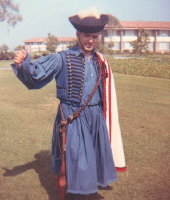
|
Folk Dance Federation of California, South, Inc.
|

|
CLICK IMAGE TO ENLARGE
The following steps are described with the Right foot leading. They may be done on either foot, moving in either direction.
- Single Csárdás Step: Step to the Right on the Right foot; close the Left foot to the Right foot without weight. OR, step to the Right on the Right foot; close the Left foot to the Right foot taking weight on the Left foot. The sequence of steps will determine whether or not you take weight on the closing foot.
- Double Csárdás Step: Step to the Right with the Right foot; close the Left foot to the Right foot taking weight; step to the Right on the Right foot; close the Left foot to the Right foot without weight.
- Cifra Step: Leap slightly to the Right on the Right foot; step onto the Left foot next to the Right foot in place but do not take full weight on the Left foot; step on the Right foot in place.
- Upbeat or Open Rida: Step onto the ball of the Right foot to the Right; step on full Left foot across and in front of the Right foot.
- Downbeat or Closed Rida: Step on full Right foot across and in front of the Left foot; step to the Left on the ball of the Left foot.
- Lengetö (Leg Swing): Leap onto the Right foot in place, bringing Left foot up slightly in back; hop on the Right foot, swinging Left foot forward.
- Fono or Fonas (Weaving Step):
- Forward: Step on the Right foot in front of the Left; hop on the Right foot, bringing the Left foot in an arc around in front of the right foot.
- Same footwork as above but the arc moves from front to back, which looks somewhat like a reel-type step-hop.
- Simple Bokázó: Step in place three times, Right-Left-Right, bringing the heels together with clicks on each step.
- Bokázó Variations:
- In a parallel 1st position, click heels together on each count.
- Open heels (ct 1); close heels with a click (ct 2).
- Step Right in place (ct 1); step Left in place (ct 2); close Right foot to the Left with a heel click (ct 3); pause (ct 4).
- Jump on both feet, landing with Right foot crossed over in front of the Left foot, heels turned in slightly (ct 1); jump on both feet apaart, heels turned out slightly (ct 2); close both feet together with weight on both feet (ct 3); pause (ct 4).
These basic steps are commonly found in Hungarian dances, and this list is by no means complete.
A useful warm-up dance or exercise can be developed from combining selected basic steps. This type of dance helps to develop a certain feeling for style and to increase the range of movement. The dance always requires a leader who is fully aware of the basic development of free-style Hungarian dances, and is able to select and demonstrate the steps, as a participating leader, in a way that is pleasing to other participants. Any good 2/4 or 4/4 Hungarian dance music can be used as accompaniment. The dance should always start with slow movements, progressing to faster and more vigorous movements.
Used with permission of the author.
Reprinted from the 1964 and 1966 University of the Pacific (Stockton) Folk Dance Camp syllabi.